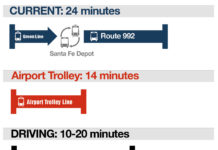By The Team at Clairemont Cares
Housing First is a knee jerk reaction to a problem long ignored. The proposed 5858 Mt. Alifan Project is Permanent Supportive Housing (PSH) intended for the chronically homeless and employs a model with zero accountability for their residents. This location is in a residential area on a road that children use to walk to multiple local schools. I am writing on behalf of Clairemont Cares, and this location is not acceptable for a Housing First model.
Housing First fails to move people out of dependency. It is an enablement model that does not require residents to be clean, sober, in treatment, in counseling, taking medications, or to work. Nor is there consequence if these things never occur. Services will be offered, but are optional.(1) There have been numerous headlines touting the success of Housing First, but when explored deeper, success is measured by dollars saved to the city instead of residents obtaining self-sufficiency.
The vulnerability index (CES)(2) used to triage the homeless into the type of housing proposed for Mt. Alifan, indicates that residents will be the chronically homeless. By definition, that means those that have been on the streets for at least 12 months and have a ‘disabling condition’. A disabling condition is defined by HUD(3) as “a diagnosable substance abuse disorder, a serious mental illness, developmental disability, or chronic physical illness or disability, including the co-occurrence of two or more of these conditions.”
Those who accept state or HUD funding must comply with Housing First rules. Funding for this project is key and will further determine who is eligible at this location. For example, Project One For All funding(4) is specific to the homeless with serious mental illness. This process of securing government funding is closed to community input.
Many cities who have employed a Housing First model are now reporting problems. The recent Utah Audit (May 2018 )(5), found widespread drug use in their facilities. Since the model was developed, Utah has increased spending on the homeless by 20 million dollars and Salt Lake City spent 85% percent of its $11.2 million in associated costs on policing.
Palmer Court is a Permanent Supportive Housing (PSH) facility in Salt Lake City and The University of Utah did a study on employment for Palmer Court residents(6). Over the 24 months the study occurred, 112 residents were capable of employment. Out of 112 only 26 (23%) held a job for over 3 months. According to the Utah Audit, Palmer Court also has “series drug problems”.
In Fresno, an article entitled(7) “The Housing First Model isn’t working for Fresno” found “only a certain percentage of homeless individuals will avail themselves of offered services”. The San Francisco Chronicle noted in its article “A Decade of Homelessness,” (8)out of 9,000 people housed, only 5% utilized the offered services.
Seattle is paying 1 billion a year on the homeless crisis(9). Friday, Amazon announced moving a new facility to Phoenix because Seattle approved a ‘head tax’ applied to large corporations because more money is needed to fund homeless/affordable housing(10).
The examples above are why Clairemont Cares opposes the Housing First model being employed by Wakeland/Path. There are other models (in San Diego!)(11) which measure success by sobriety/ employment/ and upward economic mobility of the residents. Clairemont Cares supports these models (Traditional Model/Direct Access with conditions) as we see this as a more effective solution to the homeless. The government will not fund it because it requires the accountability that Housing First does not.
Government officials will say the traditional model doesn’t work because this model means less money saved to the city on emergency services. We would argue, if the cities above are any indication of the impact of Housing First, the cost of housing the homeless will continue to increase as will the dependencies. Will this be absorbed by additional tax increases imposed on tax payers? Will San Diego tax companies as Seattle did?
This is our community, where we raise our families. We want our children to feel safe walking to school. Housing First with its lack of accountability will fail – and the residents will have to deal with the aftermath. Clairemont Cares advocates for a model that requires accountability, maintains our quality of life, ensures our families & seniors are safe, and helps people become self-sufficient.
Sincerely,
The Team at Clairemont Cares
- https://www.hudexchange.info/resources/documents/Housing-First-Permanent-Supportive-Housing-Brief.pdf
- https://www.rtfhsd.org/resource-library/coordinated-entry-system/
- https://www.hudexchange.info/resources/documents/DefiningChronicHomeless.pdf
- https://www.sandiegocounty.gov/content/sdc/sdhcd/project-one-for-all/information.html
- https://le.utah.gov/audit/18_ailr.pdf
- https://socialwork.utah.edu/wp-content/uploads/sites/4/2015/09/FinalReportPalmerCourtwithmodel.pdf
- http://gvwire.com/2017/10/24/housing-first-model-for-fresno-homeless-isnt-working/
- https://www.sfgate.com/bayarea/article/A-decade-of-homelessness-Thousands-in-S-F-5585773.php
- https://www.bizjournals.com/seattle/news/2017/11/16/price-of-homelessness-seattle-king-county-costs.html
- http://www.phoenixnewtimes.com/news/amazon-will-relocate-delivery-services-team-to-phoenix-10460679



